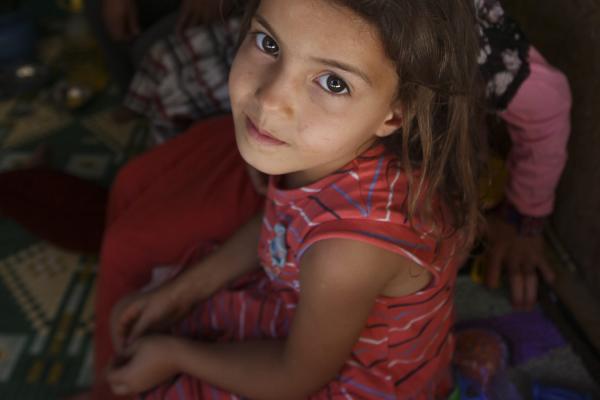The Syrian war is the largest humanitarian crisis of our time with a devastating number of deaths, displaced refugees, and separated families in Turkey, Lebanon, Jordan, and across Europe who now face ‘less-than-ideal’ settlement camp conditions. Other internally displaced refugees are trapped between ISIS and rebel groups and endure overhead bombing of civilian settlements, hospitals, and schools by countries backing either the Assad forces or the rebel groups.
While causalities of war-torn Syria are recorded in our minds, the mildly aggravating stories never quite trouble our hearts. Distance often creates barriers and empathy gets lost in the long road.
Photographs trigger empathy; to perceive tragedy, we need to see the victim. The effect is curiously more profound when we see the image of a single victim: While one death is a tragedy, a million deaths are a statistic. The photo that emerged overnight of a bloodied 5-year-old boy, wounded in an air strike in Aleppo and rescued by the White Helmets, feels hauntingly familiar. It seems to be having the same effect as the first picture to break the heart of the world: that of Aylan Kurdi, a drowned 3-year-old boy lying face-down with his soaked red shirt and blue bottoms. That image, like that of 5-year-old Omran Daqneesh, lies imprinted on our minds. It was a simple photograph with an absolute truth: A kid died and his lifeless body washed up on the shore like a piece of wood or a discarded plastic bottle; at the moment nothing seemed more savage.
The image did more than just dominate headlines. Within two weeks of the photo’s appearance, the United States Fund for UNICEF reported that donations for the refugee response had gone up 636 percent and other charities too reported surges.
Until then, and sometimes even now, photo editors use pictures of crowded boats to capture the essence of fleeing war-time destruction. This made it a story of migration (the blurring distinctions between refugees and economic migrants grabbed headlines) while the tale of conflict was only in the margins. With the image of Aylan Kurdi, the world saw the war as real people risking their lives in faint hopes of one day reaching safe land.
And now, designers/activists are hoping to tap into an international craze to reach masses with striking messages from kids in war-torn Syria — using Pokémon characters.
Last month the Revolutionary Forces of Syria Media Office, an anti-Assad media activist organization, shared photos of Syrian children with Pokémon Go characters. The drawings the children held up were all captioned with a line identifying that the child is from a particular town or village in rebel-held areas that have seen years of heavy fighting and aerial bombardment.
Artists outside the country have also borrowed the Pokémon idea. Moustafa Jano, a Syrian who now lives in Sweden posted a series of gut-wrenching pictures of Syrian children with superimposed Pokémon characters.
Saif Tahhan, a Syrian graphic designer who left Syria in 2011 and now lives in Denmark, has also drawninspiration from the game. He has produced scenes from an imaginary Syria Go game. Instead of searching for Pokémons, the quest is for security, education, and medical supplies.
Tahhan’s Facebook post has now been shared nearly 1,000 times. But in an interview with the International Business Times, his response to the popularity was: "I hope they will react very soon in the real life."
Such immersive journalism projects garner heartfelt global responses and much-needed disquieting changes in general mood. In November last year, the World Economic Forum commissioned a project called Project Syria. A team of designers created a virtual reality film where participants could ‘experience’ the war in Syria through virtual rocket hits on civilians leaving death, dust, and debris scattered everywhere.
A widespread preconception of virtual reality is that it would create reclusiveness – an unhealthy removal from this world. Such arguments are often heard against social media, too. But we forget that technology is only as good or bad as the people using it.
When the Obama administration turned to American companies to create solutions for helping refugees, Kickstarter, the crowd-funding website that has successfully financed thousands of projects, answered the call by partnering with the UNHCR to build a campaign to enable anyone to donate directly to support refugees. The campaign raised more than $1 million from more than 16,000 people within the first 24 hours and $1.77 million total.
In response to the current refugee crisis, a public Facebook group called Information Point for Lesvos Volunteers started helping independent volunteers and other grassroots projects working in Lesvos, offering a range of useful tools for current and prospective volunteers. It offers a map and information about what to expect, what to bring, who to contact, local laws and regulations, and other critical information about ground realities, thereby providing an excellent way-finding system, while current volunteers offer updated news and information from their own experiences.
These are just a few examples wherein technology pushed people into executing foreign policies based on simple humanity; it drew them in active engagement rather than just passive scrolls through websites.
Indeed, technology— social media, digital design, virtual reality — has the power to change people’s perception and move them to action. Of course, the pros-cons debates will emerge as technology advances – use of drones, driverless cars, gene-editing, etc. New worries will surface, as they should. And consequently, changes or alternate solutions will be demanded, as they must.
In the end, technology is plain with no inherent principles; it’s people who add in meaning.
Got something to say about what you're reading? We value your feedback!

